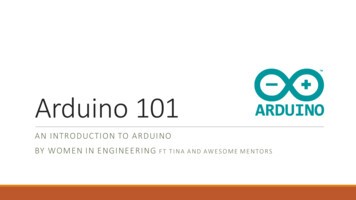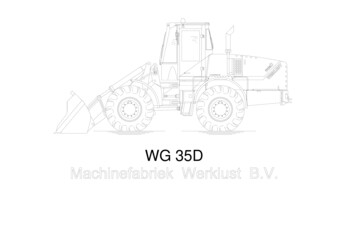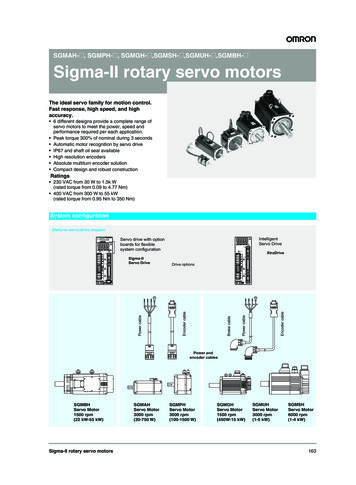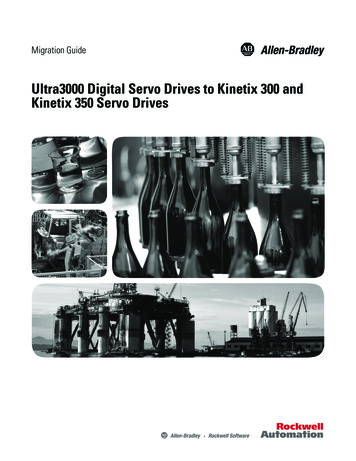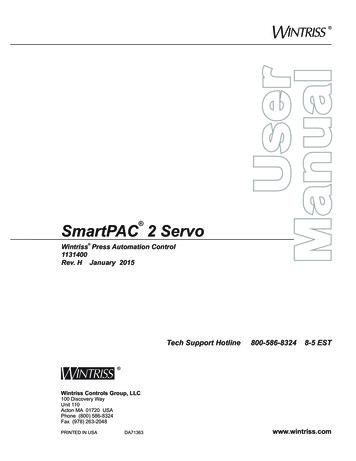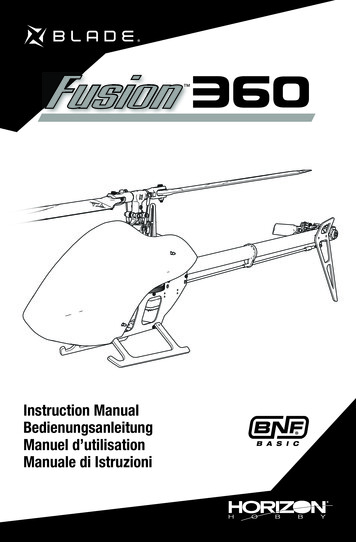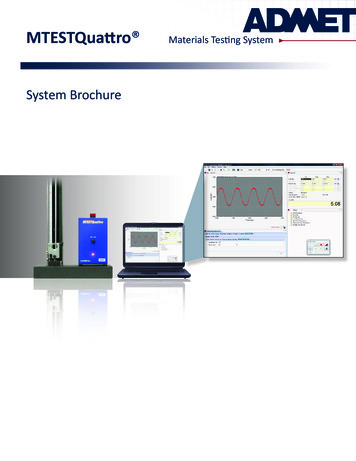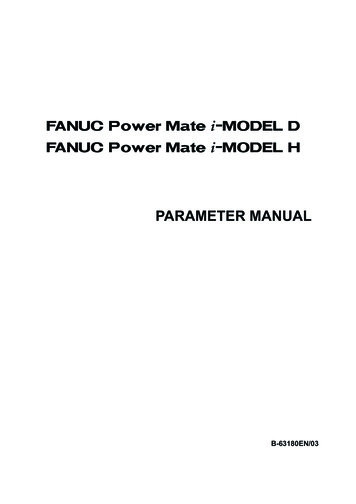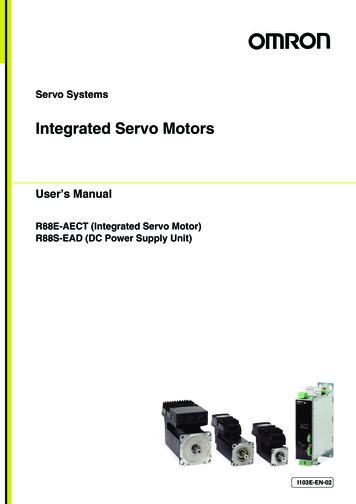
Transcription
Ultra3000Digital Servo Drivewith DeviceNetDeviceNet Firmware Version 2.xx(Catalog Numbers2098-DSD-005-DN, -005X-DN,2098-DSD-010-DN, -010X-DN,2098-DSD-020-DN, -020X-DN,2098-DSD-030-DN, -030X-DN,2098-DSD-075-DN, -075X-DN,2098-DSD-150-DN, -150X-DN2098-DSD-HV030-DN, -HV030X-DN2098-DSD-HV050-DN, -HV050X-DN2098-DSD-HV100-DN, -HV100X-DN2098-DSD-HV150-DN, -HV150X-DN2098-DSD-HV220-DN, -HV220X-DN)Reference Manual
Important User InformationBecause of the variety of uses for the products described in thispublication, those responsible for the application and use of thiscontrol equipment must satisfy themselves that all necessary stepshave been taken to assure that each application and use meets allperformance and safety requirements, including any applicable laws,regulations, codes and standards.The illustrations, charts, sample programs and layout examples shownin this guide are intended solely for purposes of example. Since thereare many variables and requirements associated with any particularinstallation, Allen-Bradley does not assume responsibility or liability(to include intellectual property liability) for actual use based uponthe examples shown in this publication.Allen-Bradley publication SGI–1.1, Safety Guidelines for theApplication, Installation and Maintenance of Solid-State Control(available from your local Allen-Bradley office), describes someimportant differences between solid-state equipment andelectromechanical devices that should be taken into considerationwhen applying products such as those described in this publication.Reproduction of the contents of this copyrighted publication, in wholeor part, without written permission of Rockwell Automation, isprohibited.Throughout this manual we use notes to make you aware of safetyconsiderations:ATTENTIONIdentifies information about practices orcircumstances that can lead to personal injury ordeath, property damage or economic loss!Attention statements help you to: identify a hazard avoid a hazard recognize the consequencesIMPORTANTIdentifies information that is critical for successfulapplication and understanding of the product.Allen-Bradley and PLC are registered trademarks of Rockwell Automation, Inc.DeviceNet is a trademark of the Open DeviceNet Vendor Association.RSNetWorx, Ultra3000, Ultra5000 and Ultraware are trademarks of Rockwell Automation, Inc.
Table of ContentsPrefaceIntroduction . . . . . . . . . . . . . . . .Who Should Use this Manual . . . .Purpose of this Manual . . . . . . . .Contents of this Manual . . . . . . . .Related Documentation . . . . . . . .Conventions Used in this Manual .Allen-Bradley Support . . . . . . . . .Local Product Support . . . . . .Technical Product Assistance .P-1P-1P-1P-2P-2P-3P-4P-4P-4Chapter 1OverviewIntroduction . . . . . . . . . . . . . . . . . . . . . . . . . . . . . . . . . . . 1-1Features . . . . . . . . . . . . . . . . . . . . . . . . . . . . . . . . . . . . . . 1-1Installing, Connecting, & Commissioning Ultra3000 Drives withDeviceNet . . . . . . . . . . . . . . . . . . . . . . . . . . . . . . . . . . . . . 1-2Parameters and Electronic Data Sheet . . . . . . . . . . . . . . . . . 1-2DeviceNet Messaging . . . . . . . . . . . . . . . . . . . . . . . . . . . . . 1-2Predefined Master/Slave Connection Set . . . . . . . . . . . . 1-3Explicit Response/Request Messages . . . . . . . . . . . . . . . 1-3Polled I/O Command/Response Messages . . . . . . . . . . . 1-3Change-of-State/Cyclic Messages . . . . . . . . . . . . . . . . . . 1-3I/O Messaging and Explicit Messaging with DeviceNet . . . . 1-4Selecting Input and Output Assemblies for I/O Messages . . 1-5Chapter 2Programming ReferenceiObject Model. . . . . . . . . . . . . . . . . . .How Objects Affect Behavior . . . .The Defined Object Interface . . . .Object Addressing . . . . . . . . . . . .Data Type Definitions . . . . . . . . . . . .Identity Object (Class ID 01H) . . . . . . .Reset Service . . . . . . . . . . . . . .Message Router Object (Class ID 02H) .DeviceNet Object (Class ID 03H) . . . . .Assembly Object (Class ID 04H) . . . . .Output Assemblies . . . . . . . . . . . .Logic Commands . . . . . . . . . . . . .Disable Serial CommunicationsPause Index . . . . . . . . . . . . . .Abort Index . . . . . . . . . . . . . .Pause Homing. . . . . . . . . . . . .Abort Homing . . . . . . . . . . . . .Preset Select 0 to 5 . . . . . . . . .Define Position . . . . . . . . . . . .Integrator Inhibit . . . . . . . . . . .Follower Enable . . . . . . . . . . .Position Strobe . . . . . . . . . . . 192-202-202-202-212-212-212-21Publication 2098-RM004A-EN-P – August 2002
iiTable of ContentsOperation Mode Override . . . . . . . . . . . . . . . . . . .Reset Drive . . . . . . . . . . . . . . . . . . . . . . . . . . . . . .Start Index. . . . . . . . . . . . . . . . . . . . . . . . . . . . . . .Define Home. . . . . . . . . . . . . . . . . . . . . . . . . . . . .Remove Offset. . . . . . . . . . . . . . . . . . . . . . . . . . . .Start Homing . . . . . . . . . . . . . . . . . . . . . . . . . . . . .Reset Faults . . . . . . . . . . . . . . . . . . . . . . . . . . . . . .Enable. . . . . . . . . . . . . . . . . . . . . . . . . . . . . . . . . .Handshake . . . . . . . . . . . . . . . . . . . . . . . . . . . . . . . . .Feedback Data Pointer . . . . . . . . . . . . . . . . . . . . . . . .Parameter Data Value and Command Data Value FieldsCommand Data Table . . . . . . . . . . . . . . . . . . . . . .Input Assemblies . . . . . . . . . . . . . . . . . . . . . . . . . . . .Logic Status . . . . . . . . . . . . . . . . . . . . . . . . . . . . . . . .At Home . . . . . . . . . . . . . . . . . . . . . . . . . . . . . . . .End of Sequence . . . . . . . . . . . . . . . . . . . . . . . . . .In Motion . . . . . . . . . . . . . . . . . . . . . . . . . . . . . . .In Dwell . . . . . . . . . . . . . . . . . . . . . . . . . . . . . . . .Registered . . . . . . . . . . . . . . . . . . . . . . . . . . . . . . .Axis Homed . . . . . . . . . . . . . . . . . . . . . . . . . . . . .Tracking . . . . . . . . . . . . . . . . . . . . . . . . . . . . . . . .Startup Commutation Done . . . . . . . . . . . . . . . . . .Positive Hardware Overtravel . . . . . . . . . . . . . . . . .Negative Hardware Overtravel . . . . . . . . . . . . . . . .Positive Overtravel. . . . . . . . . . . . . . . . . . . . . . . . .Negative Overtravel . . . . . . . . . . . . . . . . . . . . . . . .At Index 0 Position . . . . . . . . . . . . . . . . . . . . . . . .At Index 1 Position . . . . . . . . . . . . . . . . . . . . . . . .Position Limit 1 . . . . . . . . . . . . . . . . . . . . . . . . . . .Position Limit 2 . . . . . . . . . . . . . . . . . . . . . . . . . . .In Position. . . . . . . . . . . . . . . . . . . . . . . . . . . . . . .Within Position Window . . . . . . . . . . . . . . . . . . . .Zero Speed . . . . . . . . . . . . . . . . . . . . . . . . . . . . . .Within Speed Window . . . . . . . . . . . . . . . . . . . . . .Positive Current Limit. . . . . . . . . . . . . . . . . . . . . . .Negative Current Limit . . . . . . . . . . . . . . . . . . . . . .Up To Speed . . . . . . . . . . . . . . . . . . . . . . . . . . . . .Drive Enabled . . . . . . . . . . . . . . . . . . . . . . . . . . . .DC Bus Charged . . . . . . . . . . . . . . . . . . . . . . . . . .Fault Disable . . . . . . . . . . . . . . . . . . . . . . . . . . . . .Brake Active . . . . . . . . . . . . . . . . . . . . . . . . . . . . .Drive Ready . . . . . . . . . . . . . . . . . . . . . . . . . . . . .Handshake Echo. . . . . . . . . . . . . . . . . . . . . . . . . . . . .DeviceNet Communication Fault Action . . . . . . . . . . . .Using the Fault Configured Input. . . . . . . . . . . . . . . . .Using Explicit Messaging to Control the Ultra3000 . . . .Connection Object (Class ID 05H) . . . . . . . . . . . . . . . . . . .Publication 2098-RM004A-EN-P – August 412-412-412-412-412-412-422-422-432-442-45
Table of ContentsiiiParameter Object (Class ID 0FH) . . . . . . . . . . . . . . . . . . . . 2-46Get Attribute All Response . . . . . . . . . . . . . . . . . . . . 2-100Acknowledge Handler Object (Class ID 2BH) . . . . . . . . . 2-102Publication 2098-RM004A-EN-P – August 2002
ivTable of ContentsPublication 2098-RM004A-EN-P – August 2002
PrefaceIntroductionRead this preface to become familiar with the organization of themanual. In this preface, you will read about the following: Who Should Use this ManualPurpose of this ManualContents of this ManualRelated DocumentationConventions Used in this ManualAllen-Bradley SupportWho Should Use thisManualThis manual is intended for qualified service personnel responsible forsetting up and servicing the Ultra3000 with DeviceNet . You musthave previous experience with and a basic understanding of electricalterminology, programming procedures, networking, requiredequipment and software, and safety precautions.Purpose of this ManualThis manual is a reference guide for using DeviceNet to configure,monitor, or control Ultra3000 drives with DeviceNet operating withDeviceNet firmware version 2.xx.1Non-Indexing Ultra3000 DrivesIndexing Ultra3000 098-DSD-HV220X-DNPublication 2098-RM004A-EN-P – August 2002
P-2PrefaceNote: The reference guide to Ultra3000 drives with DeviceNetoperating with firmware version 1.xx is listed in the sectionbelow entitled Related Documentation.Contents of this ManualThis manual contains the following sections:ChapterRelated DocumentationPublication 2098-RM004A-EN-P – August 2002TitleContentsPrefaceAn overview of this manual.1OverviewDescribes network activity and drive figuration data and behaviors implemented inthe Ultra3000 Drive with DeviceNet are definedusing object modelingThese publications provide additional information specific to theUltra3000 Drive with DeviceNet or DeviceNet in general. To obtain acopy, contact your local Rockwell Automation office or distributor, oraccess the documents on-line at www.theautomationbookstore.comor www.ab.com/manuals/gmc.For information about:Read this document:Publication NumberA description of theUltra3000 and Ultra5000 drivesUltra Family Brochure2098-BR001x-EN-PHow to install Ultraware Ultraware CD InstallationInstructions2098-IN002x-EN-PHow to install andtroubleshoot the Ultra3000driveUltra3000 Digital ServoDrive Installation Manual2098-IN003x-EN-PConfigure, monitor, orcontrol Ultra3000 driveswith DeviceNet operatingwith firmware version 1.xxUltra3000 SeriesDigital Servo Drive withDeviceNetFirmware Version 1.xxReference Manual2098-RM001x-EN-PConfiguring the Ultra3000DSD and Ultra5000 IPDusing UltrawareUltraware User Manual2098-UM001x-EN-PHow to use RSNetWorxRSNetWorx for DeviceNetGetting Results Manual9399-DNETGR
PrefaceFor information about:Read this document:Publication NumberA glossary of industrialautomation terms andabbreviationsAllen-Bradley IndustrialAutomation GlossaryAG-7.1How to commission aDeviceNet system.DeviceNet Cable SystemPlanning and InstallationManualDN-6.7.2An overview ofAllen-Bradley motioncontrols and systemsMotion Control SelectionGuideGMC-SG001x-EN-PP-3A copy of the DeviceNet Specification, Volumes I and II, Release 2.0may be ordered from the web site http://www.odva.org of theOpen Device Vendor Association.Conventions Used in thisManualThe following conventions are used throughout this manual: Bulleted lists such as this one provide information, not proceduralsteps Numbered lists provide sequential steps or hierarchical information Words you type or select appear in bold. When we refer you to another location, the section or chaptername appears in italics Software commands and parameters are listed with initial capitalsand hardware signals are listed in all capitals (e.g., Enable Behaviorparameter, and ENABLE signal).Publication 2098-RM004A-EN-P – August 2002
P-4PrefaceAllen-Bradley SupportAllen-Bradley offers support services worldwide, with over 75sales/support offices, 512 authorized distributors and 260 authorizedsystems integrators located throughout the United States alone, plusAllen-Bradley representatives in every major country in the world.Local Product SupportContact your local Allen-Bradley representative for: Sales and order supportProduct technical trainingWarranty supportSupport service agreementsTechnical Product AssistanceIf you need to contact Allen-Bradley for technical assistance, pleasereview the information in this manual or that listed in RelatedDocumentation on page P-2 first. Then call your local Allen-Bradleyrepresentative. For the quickest possible response, we recommendthat you have the catalog numbers of your products available whenyou call.Publication 2098-RM004A-EN-P – August 2002
Chapter1OverviewIntroductionDeviceNet is an open, global industry-standard communicationnetwork. It is designed to provide an interface from a programmablecontroller through a single cable directly to smart devices such assensors, push buttons, motor starters, simple operator interfaces anddrives.FeaturesThe Ultra3000 Drive with DeviceNet Interface provides the followingfeatures: Ultra3000 Drive with DeviceNet implements the UnconnectedMessage Manager (UCMM) which is used to establish a Group 3Explicit Message connection. Up to five Group 3 Explicit Messagingconnections can be established. Faulted-node Recovery, allows the node address of a device to bechanged even when it is faulted on the network. This featurerequires the support of proper PC software tools and the NodeAddress (0-63, PGM) switches be set to the PGM (program)position. User-configurable fault response provides the ability to customizethe drive’s actions to communication errors. Software configuration lets you configure the Ultra3000 Drive withDeviceNet using RSNetWorx for DeviceNet (Version 3.00.00Service Pack 1, or later). Customize network activity by configuring the drive to:– report only new data using Change-of-State (COS) capability.– report data at specific intervals using cyclic operation. Autobaud allows the drive to determine the network data rate. Supports Automatic Device Replacement (ADR).1Publication 2098-RM004A-EN-P – August 2002
1-2OverviewInstalling, Connecting, &Commissioning Ultra3000Drives with DeviceNetThis manual serves as a reference for configuring, monitoring, andcontrolling Ultra3000 Drives with DeviceNet. Refer to the Ultra3000Digital Servo Drive Installation Manual (2098-IN003x-EN-P) forinformation regarding: Parameters and ElectronicData Sheetconfiguring the rotary switches on the front panel of the drivewiring the DeviceNet connectorunderstanding the DeviceNet LED indicatorstroubleshootingThe Ultra3000 Drive with DeviceNet contains a set of parameters thatare used to configure and monitor the drive. You can performconfiguration by changing the values associated with individualparameters. Parameter values may be written and read via DeviceNet.Writing a value to a parameter may configure drive operations such asthe acceleration or deceleration rates. Writing a value to a parametermay also configure DeviceNet operations such as which input andoutput assemblies are to be used for I/O communications with amaster (scanner). The parameter set is documented in ProgrammingReference on page 2-1.Electronic Data Sheet (EDS) files are specially formatted ASCII filesthat provide all of the information necessary for a configuration toolsuch as RSNetworx for DeviceNet to access and alter the parametersof a device. The EDS file contains information on the number ofparameters in a device and how those parameters are groupedtogether. Information about each parameter is contained in the filesuch as parameter min, max, and default values, parameter dataformat and scaling, and the parameter name and units. You can createor access an EDS file stored in the Ultra3000 Drive with DeviceNet viaRSNetworx for DeviceNet (Version 3.00.00 Service Pack 1 or later) ordownload an EDS file for the Ultra3000 Drive with DeviceNet fromRockwell Automation - Allen-Bradley web-site www.ab.com/networks/eds.DeviceNet MessagingPublication 2098-RM004A-EN-P – August 2002The Ultra3000 Drive with DeviceNet operates as a slave device on aDeviceNet network. The drive supports Explicit Messages and Polledor Change-of-State/Cyclic I/O Messages of the predefined master/slave connection set. The drive also supports the UnconnectedMessage Manager (UCMM) so that up to five Group 3 Explicit Messageconnections may be established with the drive.
Overview1-3Predefined Master/Slave Connection SetA set of messaging connections that facilitate communications and istypically seen in a master/slave relationship is known as thePredefined Master/Slave Connection set. The master is the device thatgathers and distributes I/O data for the process controller. ADeviceNet master scans its slave devices based on a scan list itcontains. Each slave device returns I/O data to its master device.The I/O data exchanged over this connection is pre-defined.Explicit Response/Request MessagesExplicit Request messages are used to perform operations such asreading and writing parameter values. Explicit Response messagesindicate the results of the attempt to service an Explicit Requestmessage.Polled I/O Command/Response MessagesThe Poll Command is an I/O message transmitted by the masterdevice. A Poll Command is directed toward a specific slave device. Aseparate Poll Command must be sent to each slave device that is to bepolled. The Poll Response is the I/O message that the slave devicetransmits back to the master device.Change-of-State/Cyclic MessagesA Change-of-State/Cyclic message is directed towards a single specificnode (master or slave). An Acknowledge response may or may not bereturned to this message. A Change-of-State message is sent at auser-configurable heart rate or whenever a data change occurs. ACyclic message is sent only at a user-configurable rate.Publication 2098-RM004A-EN-P – August 2002
1-4OverviewI/O Messaging and ExplicitMessaging with DeviceNetYou can configure and monitor the drive with either I/O Messaging orExplicit Messaging. I/O messages are for time-critical, control-orienteddata. I/O messages typically are used for moving predefined datarepeatedly with minimum protocol overhead. Explicit Messagesprovide multi-purpose, point-to-point communication paths betweentwo devices. Explicit Messaging typically would not be used toexchange data periodically since I/O Messages have a higher priorityand lower protocol overhead than Explicit Messages. However,Explicit Messages have more flexibility by specifying a service to beperformed and a specific address.Although, you can control the drive by writing to various parametersusing Explicit Messages, you should consider writing to the AssemblyObjects, which buffer the I/O data. Then the drive can be configuredto fault if a network communication fault or idle condition occurs.However, you will have to periodically update the Assembly Object toprevent the Explicit Messaging connection from closing. Refer toUsing Explicit Messaging to Control the Ultra3000 on page 2-44.If you write to a parameter using an Explicit Message, the parametervalue will be saved as a working value and in nonvolatile memory.However, if you write to a parameter using an I/O message, you canspecify whether the parameter value should be saved in nonvolatilememory or not. Therefore, if a parameter value has to be modifiedrepeatedly, then you should use I/O messaging and not save theparameter value to nonvolatile memory because the nonvolatilememory has a limited number of writes.ATTENTION!Publication 2098-RM004A-EN-P – August 2002The nonvolatile memory has a limited number ofwrite cycles. Do not save parameter values tononvolatile memory (NVMEM) unless absolutelynecessary. In other words, minimize the number oftimes parameter values are saved to nonvolatilememory (NVMEM).
OverviewSelecting Input and OutputAssemblies for I/OMessages1-5The Ultra3000 Drive with DeviceNet allows you to choose betweenvarious Input and Output Assemblies, thereby choosing the dataformat of the messages that are passed back and forth between thedrive and the master (scanner) on an I/O connection. The choice ofwhich Input and Output Assembly to use should be based on whatsort of information is appropriate in a particular system. You shouldkeep in mind that larger assemblies utilize more network bandwidth.Information on the data format of all the Assemblies is given inAssembly Object (Class ID 04H) on page 2-11, and more specificallythe following DeviceNet parameters that select input and outputassemblies: Parameter 7 - I/O Receive Select Parameter 8 - Poll Transmit (Xmit) Select Parameter 9 - COS/Cyclic Transmit (Xmit) SelectIMPORTANTIf you want to control the drive with I/O messages,Parameter 10 - Logic Command Mask must bechanged from its default value. Otherwise, if a LogicCommand is sent to the drive, the command will becleared.Publication 2098-RM004A-EN-P – August 2002
1-6OverviewPublication 2098-RM004A-EN-P – August 2002
Chapter2Programming ReferenceThe Ultra3000 Drive with DeviceNet implements a vendor specificdevice profile - Rockwell Automation Miscellaneous (Device Type:73hex).The configuration data and behaviors implemented in the Ultra3000Drive with DeviceNet are defined using object modeling. TheUltra3000 Drive with DeviceNet is modeled as a collection of objects.An Object is a collection of related attributes and services. An attributeis an externally visible characteristic or feature of an object, while aservice is a procedure an object can perform.The following general definitions also may be useful in understandingDeviceNet object modeling: Object - A representation of a particular type of data componentwithin the DeviceNet node. Instance - A specific occurrence of an Object. Attribute - A description of a characteristic or feature of an Object.Attributes provide status information or govern the operation of anObject. Service - A function performed by an Object.This manual documents the DeviceNet object models implemented inDeviceNet firmware versions 2.xx for the Ultra3000 drives.1Publication 2098-RM004A-EN-P – August 2002
2-2Programming ReferenceObject ModelThe Object Model diagram on Page 2-2 depicts the objects supportedin the Ultra3000 Drive with DeviceNet. The following table indicatesthe object classes present in this device, and the number of instancespresent in each class.Object ClassNumber of InstancesIdentity2Message Router1DeviceNet1Assembly18Connection2 - I/O6 - ExplicitParameter1059 - Indexing Drive298 - Non-indexing DriveParameter Group16 - Indexing Drive14 - Non-indexing DriveAcknowledge Handler1Figure 2.1Object ModelDeviceNet NetworkDeviceNetNodePublication 2098-RM004A-EN-P – August 2002
Programming Reference2-3How Objects Affect BehaviorThe objects in the Ultra3000 Drive with DeviceNet affect it’s behavioras shown in the table below.ObjectEffect on BehaviorMessage RouterNo effectDeviceNetConfigures port attributes (node address, data rate, and BOI)AssemblyDefines I/O data formatConnectionContains the number of logical ports into or out of the deviceParameterProvides a public interface to the device configuration dataParameter GroupProvides an aid to device configurationAcknowledge HandlerManages the reception of message acknowledgmentsThe Defined Object InterfaceThe objects in the Ultra3000 Drive with DeviceNet have the interfacelisted in the following table.ObjectInterfaceMessage RouterExplicit Messaging Connection InstanceDeviceNetMessage RouterAssemblyI/O Connection or Message RouterConnectionMessage RouterParameterMessage RouterParameter GroupMessage RouterAcknowledge HandlerI/O Connection or Message RouterPublication 2098-RM004A-EN-P – August 2002
2-4Programming ReferenceObject AddressingThe Media Access Control Identifier (MAC ID) is the common basis forlogically addressing separate physical components across DeviceNet.The MAC ID is a unique integer assigned to each DeviceNet node thatdistinguishes it specifically from among other nodes on the samenetwork. The MAC ID often is referred to as the node address. EachMAC ID is further identified with the following address components:ComponentDescriptionClass IDThe Class ID is a unique integer value assigned to each Object Classaccessible from the network. The Ultra3000 supports an 8-bit Class ID.Instance IDThe Instance ID is a unique identification assigned to an Object Instancethat identifies it among all Instances of the same Class.It is also possible to address the Class itself by utilizing the Instance IDvalue zero (0). The Ultra3000 supports an 16-bit Instance ID.Attribute IDThe Attribute ID is a unique identification assigned to a Class Attributeand/or Instance Attribute.Figure 2.2Node ObjectsDeviceNet Node 1DeviceNet Node 2MAC ID #1MAC ID #2MAC ID #4:Object Class #5Instance #2Attribute #1DeviceNet NetworkDeviceNet Node 3DeviceNet Node 4ObjectClass #5Attribute #1Attribute #2Instance#2Instance#1MAC ID #3Instance#1ObjectClass #3Instance#1ObjectClass #5MAC ID #4Publication 2098-RM004A-EN-P – August 2002
Programming ReferenceData Type DefinitionsIdentity Object(Class ID 01 )2-5The following mnemonics define the Ultra3000 with DeviceNet datatypes.MnemonicDescriptionARRAYSequence of DataBOOLBoolean (1 byte)BYTEBit String, (1 byte)DINTSigned Double Integer (4 bytes)DWORDBit String, (4 bytes)EPATHDeviceNet Path SegmentsINTSigned Integer (2 bytes)SHORT STRINGCharacter String(1 byte length indicator, 1 byte per character)SINTSigned Short Integer (1 byte)UDINTUnsigned Double Integer (4 bytes)UINTUnsigned Integer (2 bytes)USINTUnsigned Short Integer (1 byte)WORD16-bit Word, (2 bytes)This object provides identification and general information about thedevice.HIdentity Object,Attribute for Instance ID 0 (Class Attributes)Attr Access AttributeID RuleName2GetType DescriptionMax Instance UINT Maximum instancenumber of an objectcurrently created inthis class level of thedevice.Semanticsof ValuesThe largest instancenumber of a createdobject at this classhierarchy level.Identity Object,Instance ID 1 - 2Instance IDDescription1Ultra30002Ultra3000 Main FirmwarePublication 2098-RM004A-EN-P – August 2002
2-6Programming ReferenceIdentity Object,Attributes of Instance ID 1 - 2Attr. Access ication 01 Rockwell Automation/of each vendor Allen-Bradleyby number2GetVendor IDDevice TypeIndication ofgeneral typeof product.Semanticsof ValuesInstance 1:115 Rockwell AutomationMiscellaneousInstance 2:105 Subcomponent3Product CodeIdentificationof a particularproduct of anindividualvendorInstance 1:12 2098-DSD-005-DN13 2098-DSD-010-DN14 2098-DSD-020-DN15 2098-DSD-030-DN16 2098-DSD-075-DN17 2098-DSD-150-DN18 2098-DSD-005X-DN19 2098-DSD-010X-DN20 2098-DSD-020X-DN21 2098-DSD-030X-DN62 2098-DSD-075X-DN63 2098-DSD-150X-DN81 2098-DSD-HV030-DN82 2098-DSD-HV050-DN83 2098-DSD-HV100-DN84 2098-DSD-HV150-DN85 2098-DSD-HV220-DN86 2098-DSD-HV030X-DN87 2098-DSD-HV050X-DN88 2098-DSD-HV100X-DN89 2098-DSD-HV150X-DN90 2098-DSD-HV220X-DNInstance 2:01 FirmwareMajorMinorSTRUCTof:USINTUSINTRevision ofthe item theIdentity Object Major Revisionrepresents.Minor Revision5StatusWORDThis attribute See table: Identity Object,represents the Status Description ofcurrent status Attribute ID 5of the entiredevice. Itsvalue changesas the state ofthe devicechanges.6Serial Number UDINT7Product Name4Publication 2098-RM004A-EN-P – August 2002RevisionSerial numberof deviceUnique identifier for eachdevice.SHORT ReadableSTRING identificationUnique identifier for eachproduct.
Programming Reference2-7Identity Object,Status Description of Attribute ID 5Bit (s)DescriptionSemantics of Values0OwnedTRUE device has an owner12Reserved, set to 0ConfiguredAlways 03Reserved, set to 04, 5, 6, 7Vendor specific8Minor recoverablefaultAlways 09Minor unrecoverablefaultAlways 010Major recoverablefaultTRUE if self diagnosis detects a major fault11Major unrecoverablefaultAlways 012, 13Reserved, set to 014, 15Identity Object,Common ServicesServiceCodeImplemented ServiceDescriptionGet Attribute SingleReturns the contents of thespecified attribute.ResetInvokes the Reset service forthe device.Find Next ObjectInstanceCauses the specified class tosearch and return a list ofinstance IDs of existinginstances of the IdentityObject.Reset ServiceWhen the Identity Object receives a Reset request, it: determines if it can provide the type of reset requested responds to the request attempts to perform the type of reset requestedPublication 2098-RM004A-EN-P – August 2002
2-8Programming ReferenceThe Reset common service has the following object-specificparameter:Identity Object,Reset ServiceMessage Router Object(Class ID 02 )HNameDataTypeDescriptionSemanticsof ValuesTypeUSINTType
the drive's actions to communication errors. Software configuration lets you configure the Ultra3000 Drive with DeviceNet using RSNetWorx for DeviceNet (Version 3.00.00 Service Pack 1, or later). Customize network activity by configuring the drive to: - report only new data using Change-of-State (COS) capability.
